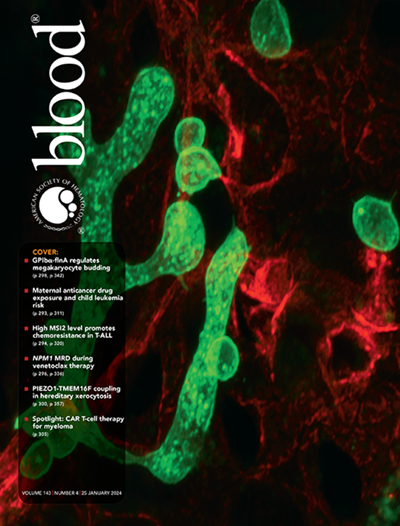Clinical phenotype and pathophysiological mechanisms underlying qualitative Low VWF.
IF 21
1区 医学
Q1 HEMATOLOGY
引用次数: 0
Abstract
Previous reports have highlighted that some low VWF patients with significant bleeding were diagnosed based upon an isolated but persistent reduction in plasma VWF activity levels in the 30-50 IU/dL range. These patients had plasma VWF:Ag levels > 50 IU/dL and thus had 'qualitative' rather than 'quantitative' low VWF. Although the clinical importance of functional VWF defects in type 2 VWD is well recognized, the translational implications of mild functional defects in patients with qualitative low VWF (low VWF-QL) have not been defined. To address this clinically important question, we combined low VWF datasets from the low VWF in Ireland cohort and the low VWF in Erasmus MC studies. Overall, we observed that low VWF-QL was common and accounted for approximately 50% of our combined low VWF cohort. Importantly, our findings demonstrate that many of these patients with mild isolated functional VWF defects in the 30-50 IU/dl range had significant bleeding phenotypes, even though their plasma VWF:Ag levels were within the normal range. In addition, we further show that low VWF-QL is a distinct clinic-pathological entity compared to type 2 VWD. Finally, our studies highlight that low VWF-QL is predominantly due to abnormalities in VWF biosynthesis within endothelial cells that are occurring largely independent of identifiable pathological VWF sequence variants. Cumulatively, these novel observations have important clinical implications for the diagnosis and management of patients with mild functional VWF defects.定性低VWF的临床表型和病理生理机制。
先前的报告强调,一些伴有严重出血的低VWF患者的诊断是基于孤立但持续的血浆VWF活性水平在30-50 IU/dL范围内的降低。这些患者血浆VWF:Ag水平在50 IU/dL左右,因此是“定性”而非“定量”的低VWF。虽然功能性VWF缺陷在2型VWD中的临床重要性已得到充分认识,但定性低VWF (low VWF- ql)患者轻度功能缺陷的翻译意义尚未明确。为了解决这个重要的临床问题,我们结合了来自爱尔兰低VWF队列和Erasmus MC研究的低VWF数据集。总的来说,我们观察到低VWF- ql是常见的,约占我们合并的低VWF队列的50%。重要的是,我们的研究结果表明,即使血浆VWF:Ag水平在正常范围内,许多患者在30-50 IU/dl范围内具有轻度分离的功能性VWF缺陷,也有明显的出血表型。此外,我们进一步表明,与2型VWD相比,低VWF-QL是一种独特的临床病理实体。最后,我们的研究强调,低VWF- ql主要是由于内皮细胞内VWF生物合成异常,这种异常在很大程度上独立于可识别的病理性VWF序列变异。总的来说,这些新的观察结果对轻度功能性VWF缺陷的诊断和治疗具有重要的临床意义。
本文章由计算机程序翻译,如有差异,请以英文原文为准。
求助全文
约1分钟内获得全文
求助全文
来源期刊

Blood
医学-血液学
CiteScore
23.60
自引率
3.90%
发文量
955
审稿时长
1 months
期刊介绍:
Blood, the official journal of the American Society of Hematology, published online and in print, provides an international forum for the publication of original articles describing basic laboratory, translational, and clinical investigations in hematology. Primary research articles will be published under the following scientific categories: Clinical Trials and Observations; Gene Therapy; Hematopoiesis and Stem Cells; Immunobiology and Immunotherapy scope; Myeloid Neoplasia; Lymphoid Neoplasia; Phagocytes, Granulocytes and Myelopoiesis; Platelets and Thrombopoiesis; Red Cells, Iron and Erythropoiesis; Thrombosis and Hemostasis; Transfusion Medicine; Transplantation; and Vascular Biology. Papers can be listed under more than one category as appropriate.
 求助内容:
求助内容: 应助结果提醒方式:
应助结果提醒方式:


